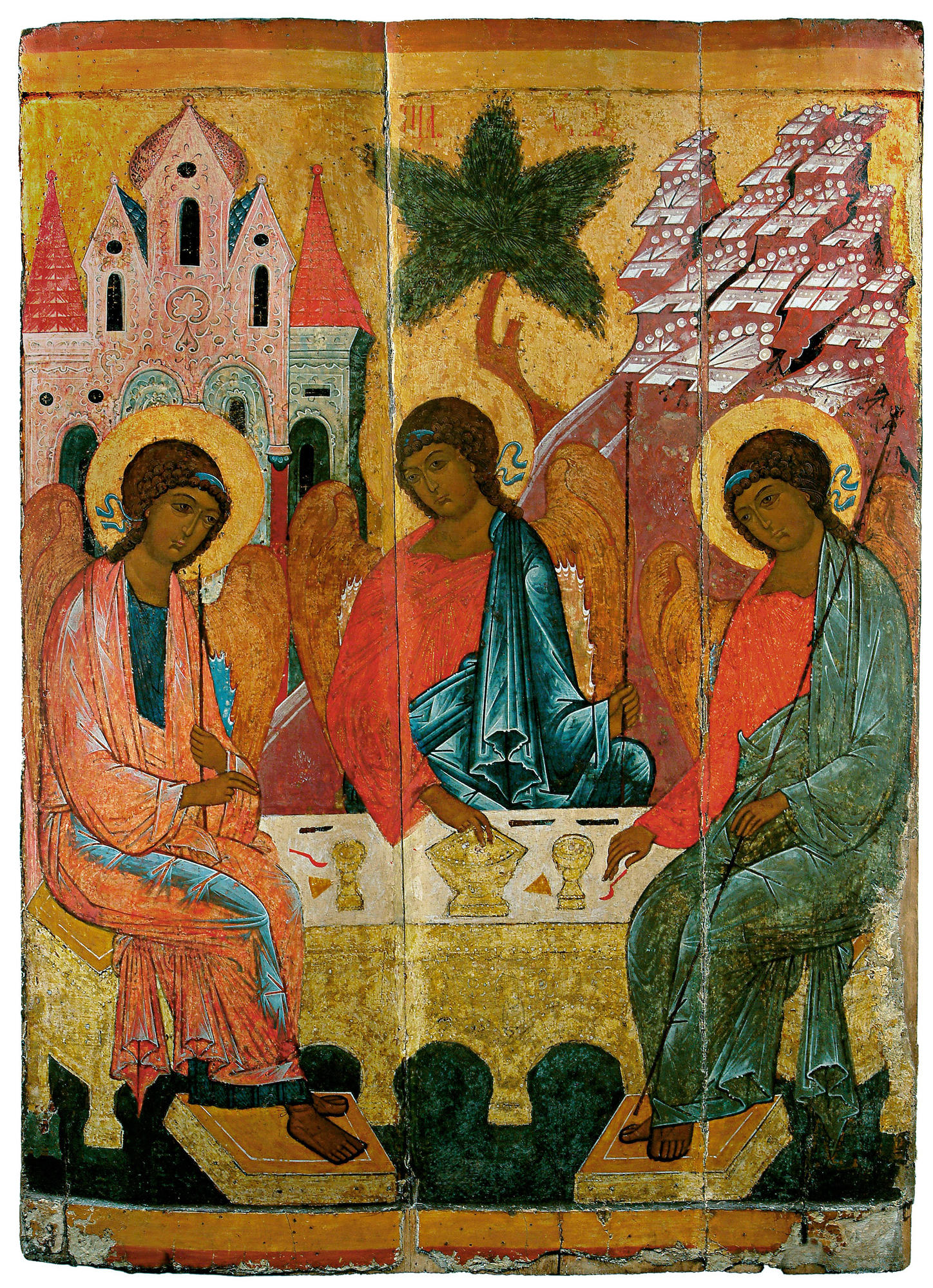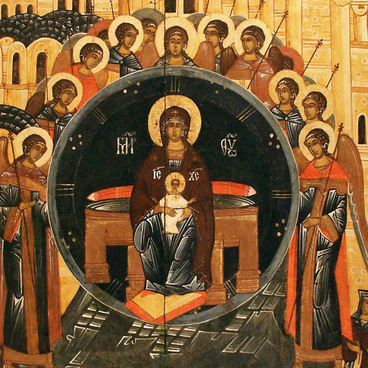The icon portraying the Holy Trinity was painted by an unknown artist in the second half of the 16th century. The picture was made for the new stone cathedral at the Saviour Monastery in Murom built in the 1560’s.
The subject of the icon is based on the Old Testament text, the episode where Lord appeared before the patriarch Abraham under the guise of three men. Abraham asked his wife Sarah to bake some bread and a slave to cook a calf for the meal. The visitors announced that Sarah would soon have a son and promised Abraham that he would “become a great and mighty nation, and all the nations of the earth shall be blessed in him”. In Christian tradition, this event was perceived as evidence of the threeness of the Divine Nature and became the basis for symbolic iconography of the Holy Trinity.
The three substances that appeared to Abraham were usually depicted as heavenly messengers, angels. Symbolically, they correspond with the three persons: the Father, the Son, and the Holy Spirit. Holy Trinity icons, The Hospitality of Abraham, acquired a special importance in Russian culture: from the turn of the 15th century, they came to be associated with the Pentecost holiday, otherwise the Descent of the Holy Spirit. The holiday got the name of the Holy Trinity day.
After the 15th century, the predominant Trinity iconography in Russian art was late Paleologan iconography. The key work of art within that iconography was Andrei Rublev’s icon, which grew into a canonical image. It retained its position in Russian icon painting until the 17th century. Typical of that image was a laconic composition, which only included representations of the three angels, the tent, the mountain, and the oak of Mamre. The oak of Mamre is the tree under which Abraham hosted God, according to the Old Testament.
Andrei Rublev’s icon served as the prototype for the icon held by the Murom museum. Yet, there are a few differences between them. For example, the angels’ figures in the Murom icon do not make a perfect circle, and their heads are almost at the same level. The chiton of the angel in the middle does not have a clavus, a vertical stripe sewn on top. Also, the Murom icon shows three cups instead of one.
Some details of the icon are rooted in the iconographic tradition of the middle or late 16th century: the luxurious building, the sophisticated shape of the dining table with an arcade at the basement, three-dimensional angel wings with folded edges, and the foot position of the right and left angels (their feet are on a rest at the same level, not at different levels as was depicted by Rublev). The icon from the Saviour monastery is much different from similar Trinity icons of the 16th century, which follow Rublev’s icon composition more accurately.
The subject of the icon is based on the Old Testament text, the episode where Lord appeared before the patriarch Abraham under the guise of three men. Abraham asked his wife Sarah to bake some bread and a slave to cook a calf for the meal. The visitors announced that Sarah would soon have a son and promised Abraham that he would “become a great and mighty nation, and all the nations of the earth shall be blessed in him”. In Christian tradition, this event was perceived as evidence of the threeness of the Divine Nature and became the basis for symbolic iconography of the Holy Trinity.
The three substances that appeared to Abraham were usually depicted as heavenly messengers, angels. Symbolically, they correspond with the three persons: the Father, the Son, and the Holy Spirit. Holy Trinity icons, The Hospitality of Abraham, acquired a special importance in Russian culture: from the turn of the 15th century, they came to be associated with the Pentecost holiday, otherwise the Descent of the Holy Spirit. The holiday got the name of the Holy Trinity day.
After the 15th century, the predominant Trinity iconography in Russian art was late Paleologan iconography. The key work of art within that iconography was Andrei Rublev’s icon, which grew into a canonical image. It retained its position in Russian icon painting until the 17th century. Typical of that image was a laconic composition, which only included representations of the three angels, the tent, the mountain, and the oak of Mamre. The oak of Mamre is the tree under which Abraham hosted God, according to the Old Testament.
Andrei Rublev’s icon served as the prototype for the icon held by the Murom museum. Yet, there are a few differences between them. For example, the angels’ figures in the Murom icon do not make a perfect circle, and their heads are almost at the same level. The chiton of the angel in the middle does not have a clavus, a vertical stripe sewn on top. Also, the Murom icon shows three cups instead of one.
Some details of the icon are rooted in the iconographic tradition of the middle or late 16th century: the luxurious building, the sophisticated shape of the dining table with an arcade at the basement, three-dimensional angel wings with folded edges, and the foot position of the right and left angels (their feet are on a rest at the same level, not at different levels as was depicted by Rublev). The icon from the Saviour monastery is much different from similar Trinity icons of the 16th century, which follow Rublev’s icon composition more accurately.



